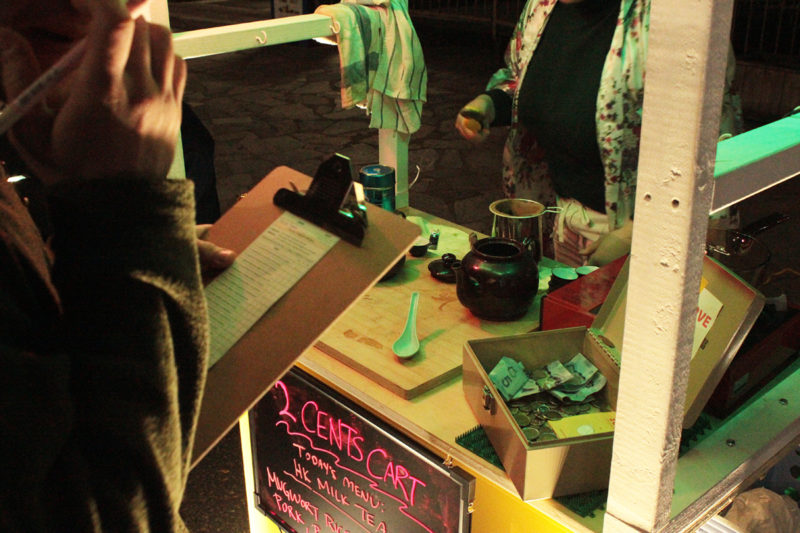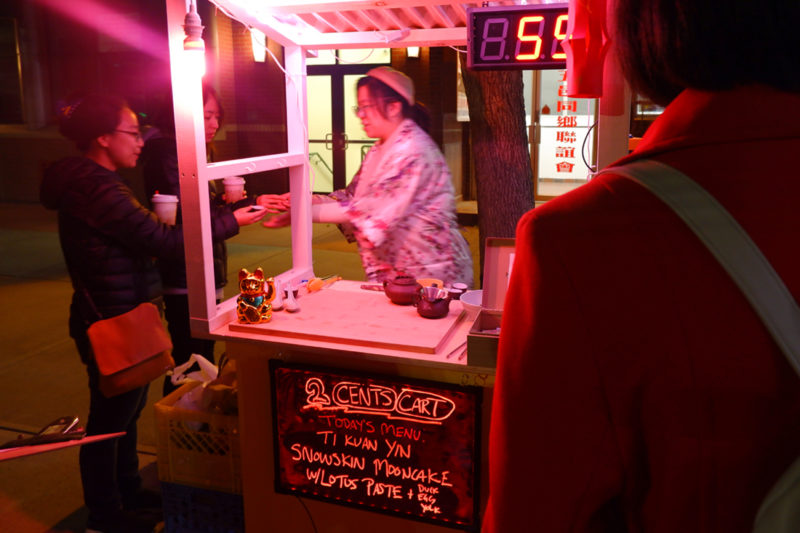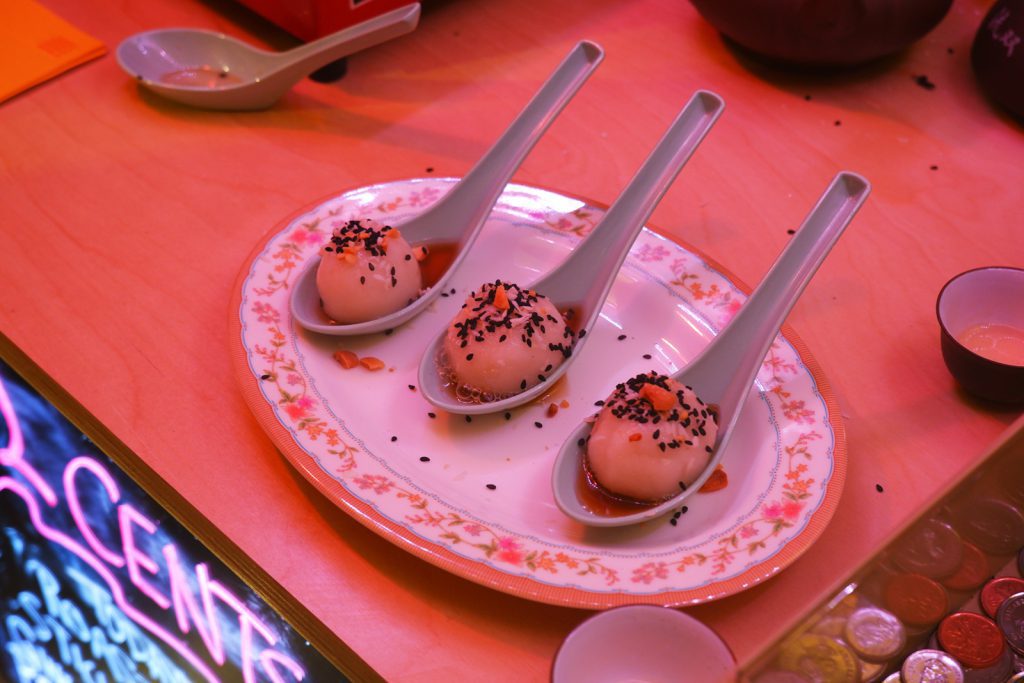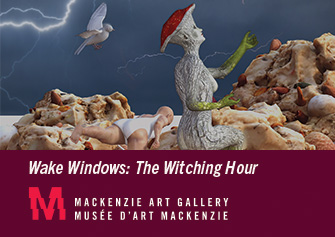Teresa Tam’s ‘2 cents cart’
21 February 2020
By Stephanie Wong Ken
A small crowd gathered around Teresa Tam’s 2 cents cart, set up in front of the CommunityWise Resource Centre in downtown Calgary. The performances were part of the programming curated by Signy Holm called Fare Trade: a fundraiser for M:ST Performative Art Festival. Around the corner, there’s an upscale eatery that sells expensive versions of dim sum and Asian street eats, another recent addition to a growing trend in the city: high-end ethnic fusion food. The crowd at Tam’s cart was a mix of arts community folks, curious onlookers, and people killing time while waiting for a table.
Dressed in a patterned apron and her trademark beanie cap, Tam stood behind the counter of the makeshift cart and served traditional Chinese teas with handmade rice cakes. Payment for the beautifully prepared snacks was either 2 cents or your two cents: answering agree, disagree, or I don’t know to a set of twenty statements created by Tam on a take-out style order form. The first statement on the form was fairly straightforward: “You would like some tea with your snack.” The remaining statements mirrored the theme of the dates of each performance: work for Labour Day, and tradition, family, and ghosts for the Super New Moon and the Mid-Autumn Festival. Each statement presented open decisions for the participant: “Tradition is a burden.” “Work is a burden.” “Sometimes ghosts embody what we eat.” “Sacrifice is needed to maintain traditions.” “Work is life.” “Tradition is life.” The form ended with a common Chinese take-out phrase, one that is often mocked by white culture yet is decidedly part of the Asian vernacular: “Thank you! Come again!” Once the participant completed the form, Tam separated the top sheet and kept the carbon copy, a receipt of the interaction.
Teresa Tam’s 2 cents cart is by turns tongue-in-cheek and sincere, examining difficult questions around identity, tradition, and worth through the seemingly simple performance of food. Audience engagement is central to Tam’s practice, such as in her recreations of a Chinese restaurant for an ordinary hole-in-the-wall along macleod before the railway underpass (Stride Gallery, 2019) and a gift shop selling authentic Chinese goods for Perfect Memory (The New Gallery, 2018). With 2 cents cart, Tam places herself directly in the public sphere, moving out of the gallery space and onto the street. By creating an experience that is both accessible and consumable, often deliciously so, the project becomes a space for bodily interaction. This framing de-centres Tam in the performance and turns the work towards the audience, making room for humour and play.

Behind this sense of play, Tam also hints at the practical and technical skills required to carry out her project. Chinese tea and rice cakes are labour-intensive, requiring preparation before and during service. To make hundreds of rice cakes for all three dates of the performance, Tam studied Youtube video tutorials and honed her skills through trial and error. The glutinous rice cake, nian gao, is a sticky sweet lucky charm traditionally prepared to celebrate Chinese New Year. The serving of tea as part of the experience reflects the complex history of this common staple at Chinese restaurants and in Chinese culture at large. Though essential to Chinese cuisine and identity, Chinese tea was also used as currency during the opium trade in the 16th century, and it is now produced on a massive scale. By serving roasted oolong, matcha, and ti kuan yin to the public, Tam acknowledges the weight and importance of Chinese tea while also engaging directly with its taste and enjoyment.
Discussions around food and identity can feel simplistic, but Tam’s approach is markedly sophisticated, with minute attention paid to everything from the symbols on the participant forms to the ingredients in each rice cake. Food is central to Asian culture, and so it becomes a powerful connector in Tam’s project, representing labour, authenticity, and tradition. The fact that Tam is offering handmade rice cakes and tea for 2 cents in proximity to a restaurant serving “reimagined” Asian staples for a much higher price, further highlights the project’s commentary on food gentrification and what is lost when food is colonized. Tam’s relationship to food is complicated by her identification as a Chinese-Canadian artist who is teaching herself how to prepare traditional foods and placing herself in the role of the server. Through the project, Tam is reclaiming her link to Chinese culture by performing this connection, and asking the audience to engage in the performance with her.

The second iteration of Tam’s 2 cents cart took place in Calgary’s Chinatown, a markedly different space to occupy. Calgary’s Chinatown, like many Chinatowns across Canada, has a contentious history, with residents continually fighting off land development and gentrification, while also housing an aging population with dwindling resources. Instead of between expensive eateries and bars, the cart was situated among a street food festival, landmark Chinese restaurants, and the Chinese Cultural Centre. In this setting for the performance, the crowd also happened to be celebrating the Mid-Autumn Festival; taking time to give thanks to the gods, and enjoy a dinner out. Tam’s cart saw the most traffic on this date, with many participants engaging with the theme of tradition and its value. It’s not surprising the Chinatown iteration was different from the others; questions around tradition, family, and work are woven into the fabric of Asian culture and life, regardless of generation or age. Part of the power of Tam’s performance is that it leaves a lot of space for differing feelings about her motives: the presentation of food and the corresponding prompts could be potentially triggering for the participants. And yet, the Chinatown performance likely had more reception because the participants were able to find a sense of kinship in the project, in the way it directly reflected their values and life experience as they try to assimilate into a western Canadian city.
As I considered each statement on Tam’s form, waffling between agree, disagree and I don’t know, I experienced the immense challenge Tam asked of the participants. To answer honestly to the definitive statements about identity, family, and tradition is challenging—ideas so personal and gigantic they felt overwhelming. In the moment, my perspective and background—a third-generation POC, with my own shifting notions of tradition and strong family connections—had suddenly never felt so relatable. Giving answers in exchange for rice cakes and tea seems straightforward, but Tam’s project posed challenging questions around identity and generosity; a significant experience that feels light in its power.
The 2 cents cart performances by Teresa Tam ran on September 2, 13, 17 and 28, 2019 as part of Fare Trade: A Fundraiser for M:ST Performative Art Festival in Calgary, AB.
Feature Image: Close up of the food served during the 2 cents cart‘s performance on September 28th, 2019 by Teresa Tam. Photo by Sergio Garcia-Palma, courtesy of M:ST Performative Art Festival.



